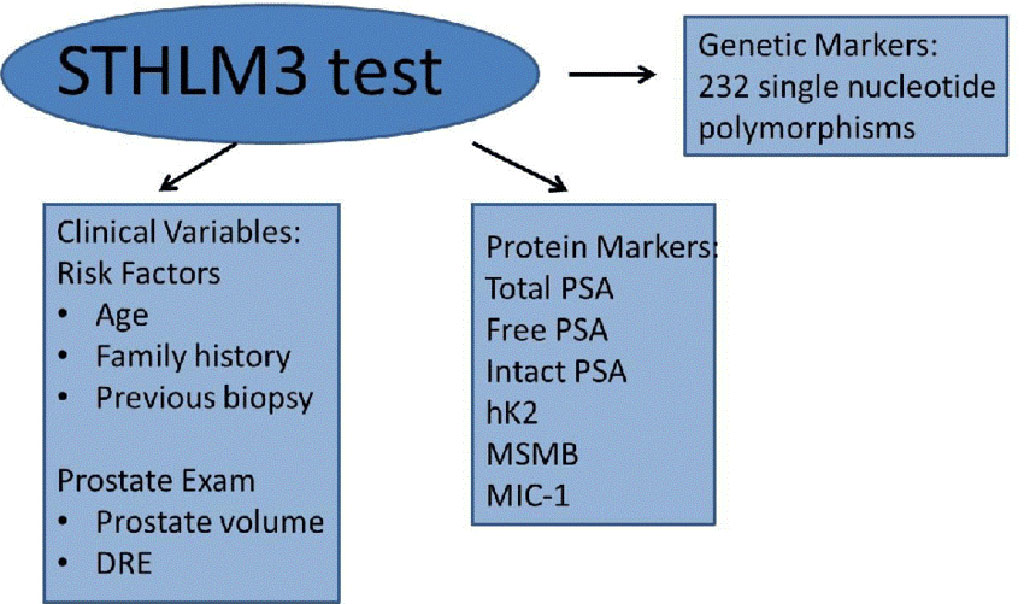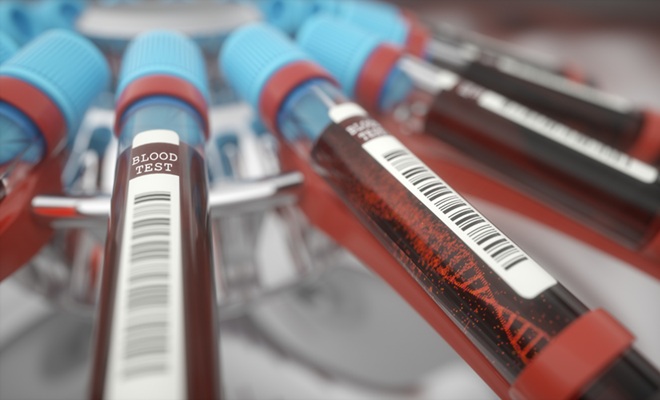Novel Blood-Based Test Bolsters MRI-Based Prostate Cancer Screening
|
By LabMedica International staff writers Posted on 23 Aug 2021 |

Image: Novel Blood-Based Stockholm3 (STHLM3) Test Bolsters MRI-Based Prostate Cancer Screening (Photo courtesy of Julie-Ann O`Reilly, PhD)
Prostate cancer does not usually cause any symptoms until the cancer has grown large enough to put pressure on the tube that carries urine from the bladder out of the penis (urethra). Symptoms of prostate cancer can include: needing to urinate more frequently, often during the night needing to rush to the toilet.
Prostate-specific antigen, or PSA, is a protein produced by normal, as well as malignant, cells of the prostate gland. The PSA test measures the level of PSA in a man’s blood. Stockholm3 is a blood test that combines protein markers, genetic markers and clinical data with an advanced algorithm in order to detect aggressive prostate cancer at an early stage.
Medical Scientists at the Karolinska Institutet (Stockholm, Sweden) carried out a prospective, population-based, randomized, open-label non-inferiority trial that included 12,750 men ages 50 to 74. Of these, 2,293 were considered to have an elevated risk of prostate cancer (i.e., a PSA level ≥3 ng/mL or a Stockholm3 score ≥0.11) who were randomized 2:3 to either the standard group (systematic prostate biopsies) or the experimental group (biparametric MRI followed by MRI-targeted and systematic biopsy in MRI-positive men).
The investigators found that the area under the receiver-operating characteristic curve for detection of clinically significant prostate cancer was 0.76 for Stockholm3 and 0.60 for PSA. In the experimental group, a Stockholm3 of 0.11 or higher was non-inferior to a PSA of 3 ng/mL or higher for detection of clinically significant prostate cancer (227 versus 192; relative proportion [RP] 1.18, and also detected a similar number of low-grade prostate cancers (50 versus 41; RP 1.22) and was associated with more MRIs and biopsies. Compared with PSA of 3 ng/mL or higher, a Stockholm3 of 0·15 or higher provided identical sensitivity to detect clinically significant cancer, and led to fewer MRI procedures. Compared with screening using PSA and systematic biopsies, a Stockholm3 of 0.11 or higher combined with MRI-targeted and systematic biopsies was associated with higher detection of clinically significant cancers (227 [3.0%] men tested versus 106 [2.1%] men tested; RP 1.44, lower detection of low-grade cancers (50 [0.7%] versus 73 [1.4%]; RP 0.46, and led to fewer biopsy procedures.
Martin Eklund, PhD, an Associate Professor and a co-author of the study, said, “Compared with the traditional PSA-based diagnostic strategy, we showed that the novel strategy of combining the Stockholm3 test and an MRI-targeted biopsy approach is associated with a 69% reduction in the rate of overdetection, while maintaining the sensitivity to detect clinically significant prostate cancer.”
The authors concluded the Stockholm3 test can inform risk stratification before MRI and targeted biopsies in prostate cancer screening. Combining the Stockholm3 test with an MRI-targeted biopsy approach for prostate cancer screening decreases over-detection while maintaining the ability to detect clinically significant cancer. The study was published on August 12, 2021in the journal Lancet Oncology.
Related Links:
Karolinska Institutet
Prostate-specific antigen, or PSA, is a protein produced by normal, as well as malignant, cells of the prostate gland. The PSA test measures the level of PSA in a man’s blood. Stockholm3 is a blood test that combines protein markers, genetic markers and clinical data with an advanced algorithm in order to detect aggressive prostate cancer at an early stage.
Medical Scientists at the Karolinska Institutet (Stockholm, Sweden) carried out a prospective, population-based, randomized, open-label non-inferiority trial that included 12,750 men ages 50 to 74. Of these, 2,293 were considered to have an elevated risk of prostate cancer (i.e., a PSA level ≥3 ng/mL or a Stockholm3 score ≥0.11) who were randomized 2:3 to either the standard group (systematic prostate biopsies) or the experimental group (biparametric MRI followed by MRI-targeted and systematic biopsy in MRI-positive men).
The investigators found that the area under the receiver-operating characteristic curve for detection of clinically significant prostate cancer was 0.76 for Stockholm3 and 0.60 for PSA. In the experimental group, a Stockholm3 of 0.11 or higher was non-inferior to a PSA of 3 ng/mL or higher for detection of clinically significant prostate cancer (227 versus 192; relative proportion [RP] 1.18, and also detected a similar number of low-grade prostate cancers (50 versus 41; RP 1.22) and was associated with more MRIs and biopsies. Compared with PSA of 3 ng/mL or higher, a Stockholm3 of 0·15 or higher provided identical sensitivity to detect clinically significant cancer, and led to fewer MRI procedures. Compared with screening using PSA and systematic biopsies, a Stockholm3 of 0.11 or higher combined with MRI-targeted and systematic biopsies was associated with higher detection of clinically significant cancers (227 [3.0%] men tested versus 106 [2.1%] men tested; RP 1.44, lower detection of low-grade cancers (50 [0.7%] versus 73 [1.4%]; RP 0.46, and led to fewer biopsy procedures.
Martin Eklund, PhD, an Associate Professor and a co-author of the study, said, “Compared with the traditional PSA-based diagnostic strategy, we showed that the novel strategy of combining the Stockholm3 test and an MRI-targeted biopsy approach is associated with a 69% reduction in the rate of overdetection, while maintaining the sensitivity to detect clinically significant prostate cancer.”
The authors concluded the Stockholm3 test can inform risk stratification before MRI and targeted biopsies in prostate cancer screening. Combining the Stockholm3 test with an MRI-targeted biopsy approach for prostate cancer screening decreases over-detection while maintaining the ability to detect clinically significant cancer. The study was published on August 12, 2021in the journal Lancet Oncology.
Related Links:
Karolinska Institutet
Latest Pathology News
- New Error-Corrected Method to Help Detect Cancer from Blood Samples Alone
- "Metal Detector" Algorithm Hunts Down Vulnerable Tumors
- Novel Technique Uses ‘Sugar’ Signatures to Identify and Classify Pancreatic Cancer Cell Subtypes
- Advanced Imaging Reveals Mechanisms Causing Autoimmune Disease
- AI Model Effectively Predicts Patient Outcomes in Common Lung Cancer Type
- AI Model Predicts Patient Response to Bladder Cancer Treatment
- New Laser-Based Method to Accelerate Cancer Diagnosis
- New AI Model Predicts Gene Variants’ Effects on Specific Diseases
- Powerful AI Tool Diagnoses Coeliac Disease from Biopsy Images with Over 97% Accuracy
- Pre-Analytical Conditions Influence Cell-Free MicroRNA Stability in Blood Plasma Samples
- 3D Cell Culture System Could Revolutionize Cancer Diagnostics
- Painless Technique Measures Glucose Concentrations in Solution and Tissue Via Sound Waves
- Skin-Based Test to Improve Diagnosis of Rare, Debilitating Neurodegenerative Disease
- Serum Uromodulin Could Indicate Acute Kidney Injury in COVID-19 Patients
- AI Model Reveals True Biological Age From Five Drops of Blood
- First-Of-Its-Kind AI Tool Visualizes Cell’s ‘Social Network’ To Treat Cancer
Channels
Clinical Chemistry
view channel
New Method Uses Pulsed Infrared Light to Find Cancer's 'Fingerprints' In Blood Plasma
Cancer diagnoses have traditionally relied on invasive or time-consuming procedures like tissue biopsies. Now, new research published in ACS Central Science introduces a method that utilizes pulsed infrared... Read more
Carbon Nanotubes Help Build Highly Accurate Sensors for Continuous Health Monitoring
Current sensors can measure various health indicators, such as blood glucose levels, in the body. However, there is a need to develop more accurate and sensitive sensor materials that can detect lower... Read moreMolecular Diagnostics
view channel
Gene-Based Blood Test Accurately Predicts Tumor Recurrence of Advanced Skin Cancer
Melanoma, an aggressive form of skin cancer, becomes extremely difficult to treat once it spreads to other parts of the body. For patients with metastatic melanoma tumors that cannot be surgically removed... Read more
Blood Test Could Identify Patients at Risk for Severe Scleroderma
Systemic sclerosis, also known as scleroderma, causes the hardening of the skin and connective tissues. In many cases, the disease can also damage vital organs, including the heart, kidneys, lungs, and... Read moreHematology
view channel
New Scoring System Predicts Risk of Developing Cancer from Common Blood Disorder
Clonal cytopenia of undetermined significance (CCUS) is a blood disorder commonly found in older adults, characterized by mutations in blood cells and a low blood count, but without any obvious cause or... Read more
Non-Invasive Prenatal Test for Fetal RhD Status Demonstrates 100% Accuracy
In the United States, approximately 15% of pregnant individuals are RhD-negative. However, in about 40% of these cases, the fetus is also RhD-negative, making the administration of RhoGAM unnecessary.... Read moreImmunology
view channel
Stem Cell Test Predicts Treatment Outcome for Patients with Platinum-Resistant Ovarian Cancer
Epithelial ovarian cancer frequently responds to chemotherapy initially, but eventually, the tumor develops resistance to the therapy, leading to regrowth. This resistance is partially due to the activation... Read more
Machine Learning-Enabled Blood Test Predicts Immunotherapy Response in Lymphoma Patients
Chimeric antigen receptor (CAR) T-cell therapy has emerged as one of the most promising recent developments in the treatment of blood cancers. However, over half of non-Hodgkin lymphoma (NHL) patients... Read moreMicrobiology
view channel
Handheld Device Delivers Low-Cost TB Results in Less Than One Hour
Tuberculosis (TB) remains the deadliest infectious disease globally, affecting an estimated 10 million people annually. In 2021, about 4.2 million TB cases went undiagnosed or unreported, mainly due to... Read more
New AI-Based Method Improves Diagnosis of Drug-Resistant Infections
Drug-resistant infections, particularly those caused by deadly bacteria like tuberculosis and staphylococcus, are rapidly emerging as a global health emergency. These infections are more difficult to treat,... Read more
Breakthrough Diagnostic Technology Identifies Bacterial Infections with Almost 100% Accuracy within Three Hours
Rapid and precise identification of pathogenic microbes in patient samples is essential for the effective treatment of acute infectious diseases, such as sepsis. The fluorescence in situ hybridization... Read moreTechnology
view channel
Pain-On-A-Chip Microfluidic Device Determines Types of Chronic Pain from Blood Samples
Chronic pain is a widespread condition that remains difficult to manage, and existing clinical methods for its treatment rely largely on self-reporting, which can be subjective and especially problematic... Read more
Innovative, Label-Free Ratiometric Fluorosensor Enables More Sensitive Viral RNA Detection
Viruses present a major global health risk, as demonstrated by recent pandemics, making early detection and identification essential for preventing new outbreaks. While traditional detection methods are... Read moreIndustry
view channel
Cepheid and Oxford Nanopore Technologies Partner on Advancing Automated Sequencing-Based Solutions
Cepheid (Sunnyvale, CA, USA), a leading molecular diagnostics company, and Oxford Nanopore Technologies (Oxford, UK), the company behind a new generation of sequencing-based molecular analysis technologies,... Read more
Grifols and Tecan’s IBL Collaborate on Advanced Biomarker Panels
Grifols (Barcelona, Spain), one of the world’s leading producers of plasma-derived medicines and innovative diagnostic solutions, is expanding its offer in clinical diagnostics through a strategic partnership... Read more























